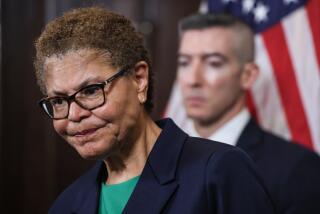L.A. Schools Face a New Budget Crisis
- Share via
Still reeling from $274 million in budget cuts this school year that slashed hundreds of teaching positions and increased the size of already crowded classes, the Los Angeles Unified School District is facing another shortfall of as much as $150 million, school officials said Monday.
The Los Angeles Board of Education has appointed the accounting firm of Ernst & Young to determine, along with district staff, how large the shortfall will be, why it is occurring and how it could have been averted.
The potential deficit was discovered during preparation of a midyear review of the district’s income and expenses.
“We are shocked,” said board member Mark Slavkin. “I will insist that there be accountability for a budget gap of this magnitude.”
Robert Booker, the district’s chief business and financial officer, emphasized that the projected shortfall is a preliminary figure, and that final figures will be presented to the board Feb. 11, along with recommendations on what steps to take.
Booker explained that district staff members are looking at income and expenditures through December to make projections for the remainder of the fiscal year, and comparing those figures to what has been allotted in the budget.
Supt. Bill Anton said in a written statement released Monday that the shortfall may be the result of a number of problems, including declining lottery revenues caused by sagging ticket sales, and less-than-anticipated savings from previous budget cuts. But, Anton said, district expenses continue to rise in several areas, including health and medical services.
Jan Sterling, of the state Department of Education’s school business services division, said the projected per-student lottery allotment statewide may drop as much as $40 below last year’s $128. Public education receives about 34% of the revenue generated by the lottery.
United Teachers-Los Angeles President Helen Bernstein said she was told that the deficit is also because of district miscalculations. She said she and other employee union heads were informed in a special meeting Friday that the district failed to add in the cost of health benefits when it rehired as substitutes many of the 2,000 teachers who had been laid off last year.
The teachers union has not offered any suggestions for cuts that the district could make to offset the shortfall. But Bernstein said: “We would not advocate anything that’ll hurt our members or our programs.”
Though more spending reductions may be necessary, Anton and school board President Warren Furutani said the administration has no intention of recommending a cut in employee health and medical benefits to offset the shortfall--a prospect that was suggested last spring when the district had to make $241 million in cuts.
“I want to assure all of our district employees . . . I have no intention or plan to recommend any cut in employee health and medical benefits this year,” Anton said. “I am confident, and our employees should be, too, that together we will weather this unexpected financial setback.”
But several board members said they questioned how the district could handle another significant deficit.
“It’s difficult for me to fathom where we’re going to make up $150 million in the next six months,” said board member Leticia Quezada. “We adopted a budget that we understand was completely balanced. . . . It’s unthinkable to go back into this year’s budget and do it again.”
Quezada said she was concerned that the district’s credibility will be damaged by the latest deficit projection. “The board needs some assurances from an outside auditor that this is an aberration and there’s no way this could have been predicted.”
The projected budget gap and cuts that may be necessary to close it are the latest financial problems to rock the school district, which has made more than $650 million in budget cuts over the last three years. The most recent round of spending reductions occurred in August when the school board eliminated more than 800 teaching positions by increasing the number of students in elementary and junior high classes. The board also ordered a 3% pay cut for all employees.
“The options are very limited,” Slavkin said. “Much of the budget is governed by contracts with different employee groups, so they’re locked in. That’s what’s so alarming. Your options are few and none of them very good.”
Though district staff will be making recommendations on how to address the shortfall, Quezada said the district may have to dig deeper into district reserve funds or look into trying to postpone certain large payments until the next fiscal year.
Even with such alternatives, prospects look dismal, Quezada said. “In a district where employees have already been severely cut in their pay and children are being stuffed in overcrowded classrooms, how much (further) can we go? We have gone to the limits already and yet we are facing the prospect of going beyond.”
Times education writer Sandy Banks contributed to this story.
More to Read
Sign up for Essential California
The most important California stories and recommendations in your inbox every morning.
You may occasionally receive promotional content from the Los Angeles Times.













